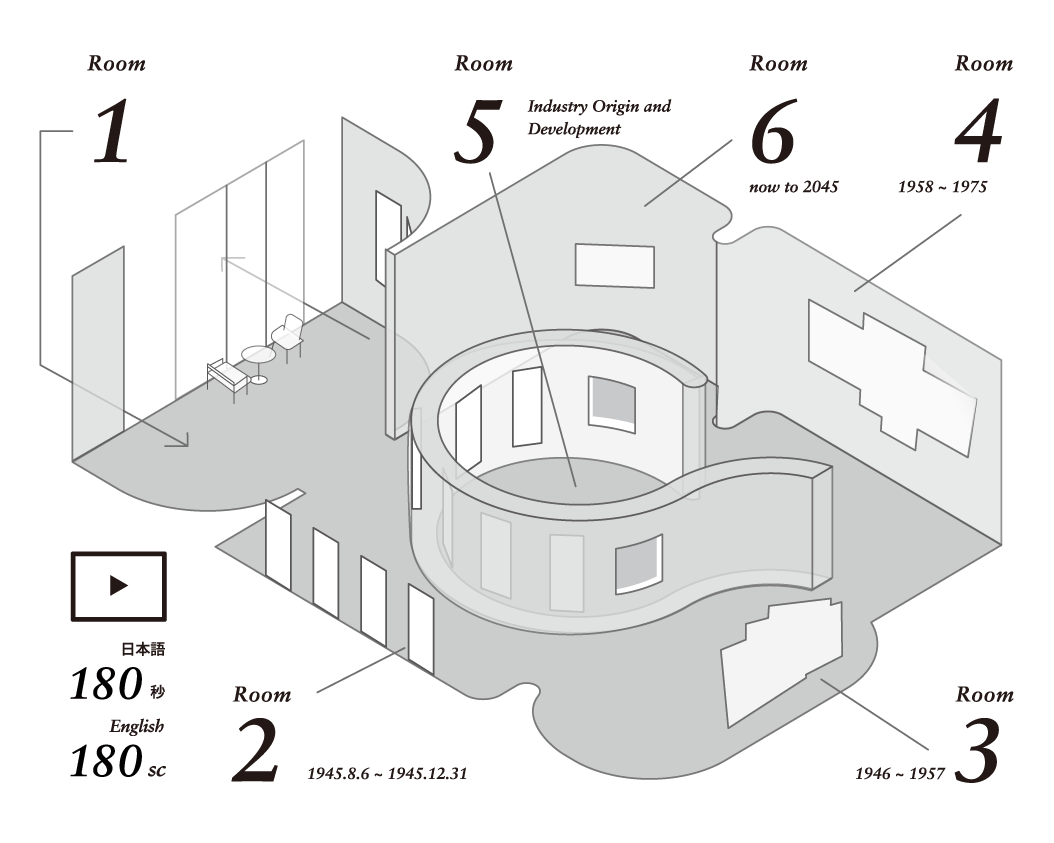Pride of Me 私たちが創る未来
前向きに
今日を生きる人の
輪を広げる
今日を生きる人の
輪を広げる
菖蒲田 清孝
代表取締役会長
工藤 あみ
総務部 地域リレーショングループ
2021年入社
2021年入社
参画企業
マツダ(株)
マツダ(株)
原子爆弾により、広島は大きな被害を受け、マツダも多くの従業員とその家族の尊い命を失いました。しかし、我々の先輩は生かされた命を見つめ、戦後4カ月後の1945年12月に三輪トラックの生産を再開し、広島の復興へ向けて力強く前進していきました。平和を希求し、行動を起こす。今、この生活があるのは、先人が紡いできた歴史の結果です。そして次は私たちの番です。広島の復興の一翼を担った地元企業の使命感や矜持に触れ、感じていただくきっかけとして、この場が活用されることを祈念します。
- 菖蒲田 清孝
マツダに入社するまで広島に縁もゆかりも無かった私ですが、今では日々地域とのつながりを感じながら働いています。展示を訪れるたびに、広島の地元企業が歩んできた復興の歴史に触れ、平和の大切さについて改めて考えさせられます。そして「今の私には地域のために何ができるのか」と自分自身に問いかけるきっかけとなっています。これからも地域の皆さまとのつながりを大切にしながら、いきいきとする体験をお届けし、前向きに今日を生きる人の輪を広げてまいります。
- 工藤 あみ
広島の復興とマツダ
終戦直後、物資を運ぶための自動車が必要とされる様子をマツダは目の当たりにする。しかし、自動車の生産には多くの資材や部品を必要とするため、生産再開時期は見通せなかった。終戦直後の混乱の中、ある者は復旧ままならない鉄道を乗り継ぎタイヤを求めて九州へ出向き、ある者は燃料タンクを譲り受けて鉄板を切り出した。マツダの希望が実を結び、1945 年12 月に10 台の三輪トラックを生産した。戦後わずか4ヶ月後のことであった。
HIROSHIMA’S RECONSTRUCTION AND MAZDA
Just after the war, Mazda saw firsthand how urgently a utomobiles were needed so that goods and supplies could be transported. However, the manufacture of automobiles also required many materials and parts, so it was an open question when production could restart. In the turmoil immediately after the fighting, Mazda sent people to Kyushu in search of tires, changing trains often as rail service had not been fully restored. Others bought old fuel tanks, which were cut up for the steel panels. Mazda’s hopes fared well. The company rolled out 10 three-wheeled trucks in December 1945, no more than four months after the war ended.
HIROSHIMA’S RECONSTRUCTION AND MAZDA
Just after the war, Mazda saw firsthand how urgently a utomobiles were needed so that goods and supplies could be transported. However, the manufacture of automobiles also required many materials and parts, so it was an open question when production could restart. In the turmoil immediately after the fighting, Mazda sent people to Kyushu in search of tires, changing trains often as rail service had not been fully restored. Others bought old fuel tanks, which were cut up for the steel panels. Mazda’s hopes fared well. The company rolled out 10 three-wheeled trucks in December 1945, no more than four months after the war ended.
1950 年代のマツダの三輪トラックと広島市内の風景。マツダの三輪トラックは市民の生活の足となり、戦後復興の一翼を担った。
Scenes from the 1950s showing Mazda’s three-wheeled trucks around Hiroshima City. These trucks were people’s daily transportation and played an important role in the city’s postwar reconstruction.
Scenes from the 1950s showing Mazda’s three-wheeled trucks around Hiroshima City. These trucks were people’s daily transportation and played an important role in the city’s postwar reconstruction.
戦後、海外に向けて発行した三輪トラックのパンフレット。赤く塗装された三輪トラックを表紙に、広島の復興を力強く印象づけた。
Postwar pamphlet produced for overseas distribution, showing a three-wheeled truck. The red truck on the cover made a strong impact, emphasizing Hiroshima’s road to recovery.
Postwar pamphlet produced for overseas distribution, showing a three-wheeled truck. The red truck on the cover made a strong impact, emphasizing Hiroshima’s road to recovery.
平和都市広島とマツダ
「平和だからこそ運転を楽しめる」マツダが皆さまから教えていただいたことです。
PEACE CITY HIROSHIMA AND MAZDA
“We are at peace now, that’s exactly why it’s fun to drive.” This is what Mazda has learned from people.
PEACE CITY HIROSHIMA AND MAZDA
“We are at peace now, that’s exactly why it’s fun to drive.” This is what Mazda has learned from people.
フラワーフェスティバルとマツダロードスター
(フラワーフェスティバルロードスターパレード実行委員会)
HIROSHIMA FLOWER FESTIVAL AND MAZDA ROADSTER
(フラワーフェスティバルロードスターパレード実行委員会)
HIROSHIMA FLOWER FESTIVAL AND MAZDA ROADSTER
広島市街とマツダ本社
HIROSHIMA CITY CENTER AND MAZDA HEAD OFFICE
HIROSHIMA CITY CENTER AND MAZDA HEAD OFFICE
マツダ(株)
1920年に広島で創立し、“工業で社会に貢献する”という志のもと、地域の皆さまと共に育ってきました。クルマを通じて、いきいきとする体験を皆さまにお届けしてまいります。
〒730-8670 広島県安芸郡府中町新地3番1号

復興に尽力した企業に残る80年前からの資料を基に、広島在住のクリエイターの視点を介し復興を感じ取る場「Pride of Hiroshima」の展示を現地でご覧ください。
Divide the footprints of the era related to reconstruction into six categories
Please take a look at the "Pride of Hiroshima" exhibition, a place where you can get a sense of the recovery through the perspective of creators living in Hiroshima, based on documents from 80 years ago that remain at companies that worked hard for the recovery.

お問い合わせ